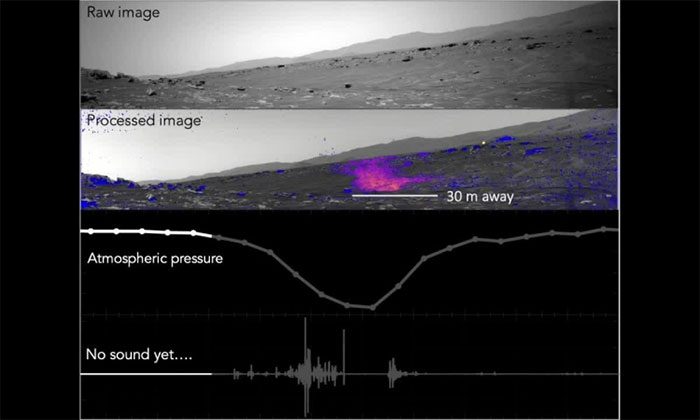The first audio recording of a dust storm on the surface of Mars reveals a dust vortex that “engulfed” the Perseverance rover in September 2021, reaching a height of 119 meters.
Naomi Murdoch, a physicist at the French National Aerospace Institute (ISAE-SUPAERO) at the University of Toulouse, and her colleagues analyzed the sound of the dust vortex, also known as a dust devil in a study published on December 13 in the journal Nature Communications. “We could actually hear the noise of particles colliding with the rover. The sound of these collisions allows us to count how many dust particles were in the vortex,” Murdoch shared.
(Video: NASA)
Dust exists throughout the surface and atmosphere of Mars. The movement of dust affects both the weather and climate on Mars while being influenced by the environment as well. Understanding the movement of dust is crucial for modeling Mars’s climate, which is essential for planning missions to the planet. For instance, the wind sensor on the Perseverance rover was damaged by dust, and the InSight Lander is nearing the end of its operational life due to dust accumulation on its solar panels, limiting the available power for scientific monitoring.
Dust storms occur when warm air near the ground rises and swirls, carrying dust and sand. The Jezero Crater, where the Perseverance rover is exploring, frequently experiences dust whirlwinds. According to Murdoch and her colleagues, the Mars Environmental Dynamics Analyzer (MEDA) on the rover, which monitors environmental characteristics such as temperature, dust, humidity, and wind, recorded at least 91 dust whirlwinds in the vicinity. However, on September 27, 2021, a dust vortex swept over the rover. The MEDA device not only collected data during the encounter with the vortex, but Perseverance’s positioning camera also captured images, and the SuperCam microphone recorded the event.

The Perseverance rover recorded the dust vortex on Mars.
By combining these three data sources, Murdoch’s team discovered that the vortex was 25 meters wide, nearly 10 times the size of the rover. With a height of 119 meters, this vortex is equivalent to the height of a 40-story building. The massive vortex moved at a speed of 19 km/h with maximum wind speeds reaching 50 km/h. However, the atmosphere on Mars is much thinner than that of Earth, meaning that even with high wind speeds, the force of the wind is significantly lower due to the lower number of particles in the atmosphere.
In a typical dust vortex, most of the dust is concentrated along the edges of the whirlwind. However, the dust impacting the rover came from three distinct streams: from the sides of the vortex and a dust cloud at its center. The accumulation of dust within the vortex is an unusual finding, according to Murdoch. “Currently, we do not fully understand how dust rises from the surface of Mars, but this is an important part of modeling both dust whirlwinds and dust storms. With the microphone, we can directly observe the process of dust rising and determine the conditions under which this occurs.“


















































